

Third-party plugins come in both free and premium options so, let’s discuss both and you can decide which one will best fit your needs. Once the edited file is saved, close your plugin, and that audio file will be updated in Ableton Live.This will be a destructive edit so make sure that all your changes are confirmed before saving the file.After editing the sample, click Save or Export as WAV or Overwrite Original File.This will automatically open the configured Sample Editor.


Lets take an audio recording of you speaking as an example, you’ve setup your microphone in a quiet room and recorded yourself talking,īut when listening back, you can hear a hiss/hum or other unwanted sounds in the local environment. It’s important to understand that both of these are very different. The two ways background noise can be removed using Ableton Live are by using either a ‘Noise Gate’ or ‘De-Noiser’. The Difference Between a ‘Noise Gate’ and ‘De-Noiser' Premium De-Noising plugins for Ableton Live.Free 3rd party De-Noising Plugins for Ableton Live.De-Noising in Ableton Live With 3rd Party Plugins.Using Ableton Live's Stock Devices To Remove Background Noise.The Difference Between a Noise Gate and De-Noiser.Here’s what you’ll learn in this article: In this article, I’ll explain the various ways that you can remove background noise in Ableton Live. These do different things but both can help to lessen and even completely remove unwanted background noise. The best way to reduce unwanted background noise with Ableton live is by using either a ‘De-Noiser’ or ‘Noise Gate’ device. If you can’t fix this before you start recording, the next best option is to do it by editing your audio recording afterwords.īut that’s not always a piece of cake either! Hiss from your audio interface, hum from the computer's fan, guitar buzz, microphone noise, or general surrounding commotion can ruin your audio. It can be pretty challenging to cancel out all background noise while recording.


 0 kommentar(er)
0 kommentar(er)
